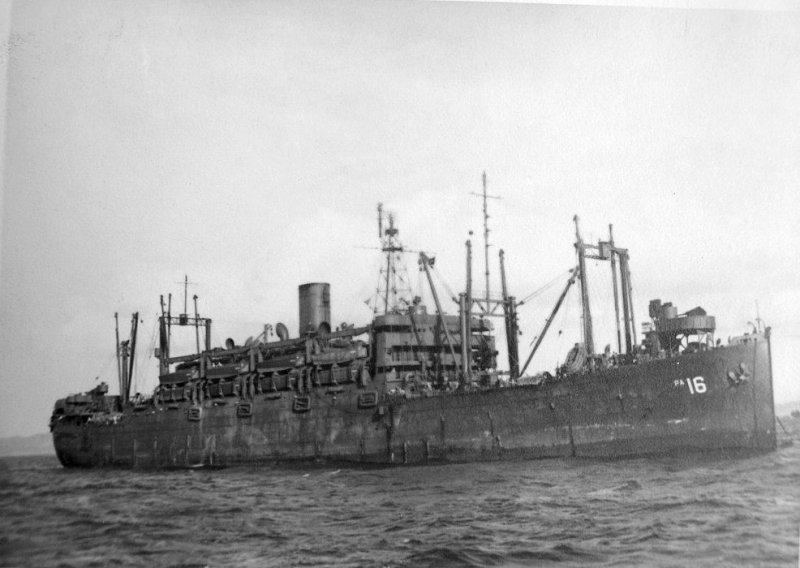|
|
An Army name retained. James Franklin Bell was born at
Shelbyville, Ky., and graduated from the Military Academy in 1878. Frontier duty
filled most of his years as a junior officer. During the Philippine
Insurrection near Porac, Luzon, 11 December 1899, he "charged seven
insurgents with his pistol and compelled the surrender of the captain and two
privates under a close fire from the remaining insurgents concealed in a
bamboo :thicket." His heroism on this occasion won him the Medal of
Honor.
Promoted to major general in 1907, Bell served as Chief of Staff of the U.S.
Army from 1006 to 1910. He died in New York City 8 January 1919.
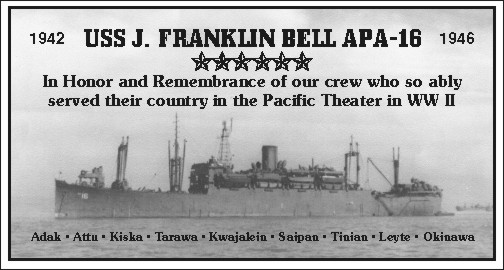
J. Franklin Bell (AP-34) was laid down in 1918 as an
Army transport by the New York Shipbuilding Corp. of Camden, N.J.; completed
I March 1921 as a passenger and cargo ship named Keystone State; turned over
to Pacific
Steamship Co. 28 May and President McKinley 9 June 1922; and transferred to
Admiral Oriental Line 21 December to operate in the Pacific until laid up in
Seattle in 1938
.
The Army purchased her 26 October 1940, renamed her J. Franklin Bell, and
converted her into a military transport. She was transferred to the Navy 26
December 1941 ; and commissioned in ordinary before commissioning in full at
San Francisco 2 April 1942, Captain H. J. Grassie in command.
After shakedown, a round-trip voyage to Pearl Harbor, and over 2 months of
amphibious training along the California coast, J. Franklin Bell, carrying
some 1,500 troops and a full load of cargo, sailed from San Francisco 13
August and headed via Kodiak, Alaska, for Adak to strengthen American
defenses in the Aleutians, then threatened with invasion.
Upon returning San Diego 29 September, J. Franklin Bell resumed coastal
operations and amphibious training in preparation for taking the offensive in
the Aleutians by recapturing Attu Island. Reclassifled
APA-16 1 February 1943, she continued rehearsals until sailing to San
Francisco 16 April to embark troops and their war gear. She got under way 24
April for Cold Bay, Alaska. Though hampered by heavy seas, her task force
arrived off Attu 11 May in a dense fog. J. Franklin Bell, now under Comdr. J.
B. McGovern, began landing operations. Submerged rocks, pea soup weather, and
narrow, rocky beaches permitted only two or three boats to be unloaded at a
time. Two days later she started unloading around the clock, enabling her to
finish the task, embark casualties, and head for home by 16 May.
After training throughout June, she embarked some 1,750 soldiers and,
following 2 weeks of landing rehearsals, departed San Diego 29 July for Adak.
At the end of a week of weather and terrain conditioning there, she steamed
for Kiska 13 August. She
sent her landing boats ashore through rough surf only to find the enemy had
fled. Unloading operations completed in 2 days, she embarked 600 troops and
sailed for San Francisco the 20th.

Above: This is the USS Chemung (AO-30) upon which RDM also served.
At San Francisco she discharged the troops and embarked naval passengers for
Wellington, New Zealand, where she arrived 30 September. During the ensuing
month of amphibious assault training, Captain 0. H. Ritchie took command 22
October. After embarking 1.800 marines, she sailed 1 November for final
landing rehearsals before departing 13 November to invade Tarawa.
The first step in a mighty amphibious offensive through Micronesia, the
conquest of the Gilbert Islands was a major milestone on the watery road to
Japan. During midwatch 20 November, J. Franklin Bell took her assigned place
off Betio, the most formidable Japanese garrison on Tarawa Atoll. Heavy naval
bombardment began at 0515; and the enemy responded with scattered fire at the
transports. Straddled, J. Franklin Bell retired out of range and, while the
deadly battle raged on ashore, awaited orders to land her troops. The next
day she sailed to Bairiki Island and landed her marines. Finding dead enemies
only, they boarded landing boats and moved from island to island along the
atoll. Meanwhile, after the Bairiki landings, J. Franklin Bell began sending
cargo ashore. The marines secured Betio on the 23d and the entire atoll on 27
November, and J. Franklin Bell departed with marines embarked for Pearl
Harbor.
After a month of training in Hawaii, the transport embarked more than 1,500
soldiers and sailed for Kwajalein Atoll. Upon arriving 31 January, she found
fire support ships pounding enemy shore installations in preparation for
landings the following day. J. Franklin Bell entered the lagoon 2 February to
unload supplies and to receive casualties. On the 5th, her landing boats
assaulted Gugegwe Island. Two days later the atoll was secured; and the
transport departed 8 February for Pearl Harbor carrying over 2,000 soldiers.
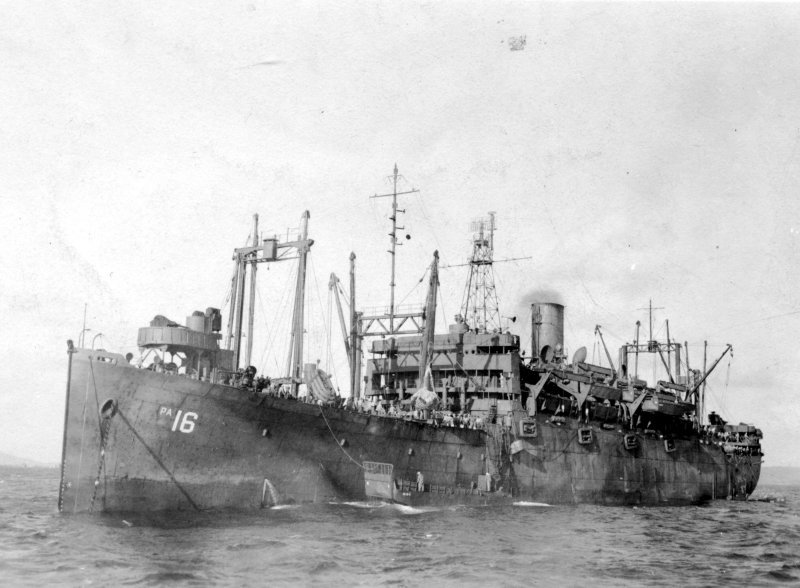
Putting into Pearl 15 February. she made two round trips to the United States
mainland before embarking soldiers and setting course for the Marianas. J.
Franklin Bell arrived off Saipan 16 June, the day after the initial landings;
and debarked her troops on the 17th. After unloading needed supplies, she
retired some 100 miles northeast of Saipan to await the outcome of the Battle
of the Philippine Sea 19 to 21 June. Upon learning of :the great American
naval victory, she returned to Saipan 25 June; completed unloading; embarked
casualties; sailed for Eniwetok to load more cargo; and then headed, via Saipan
to embark marines, for the assault on nearby Tinian.
Departing 24 July, J. Franklin Bell joined in a diversionary demonstration at
the southern end of Tinian.
Under cover of a fierce bombardment, the transport feigned two landings to
divert enemy attention while the real landings were made at the northern end
of the island. Following this successful subterfuge, she sailed to the actual
beachheads; landed her troops; embarked casualties the next afternoon; and
returned to Saipan the 27th. The next day, carrying 438 Japanese prisoners,
she sailed for Pearl Harbor and arrived 10 August.
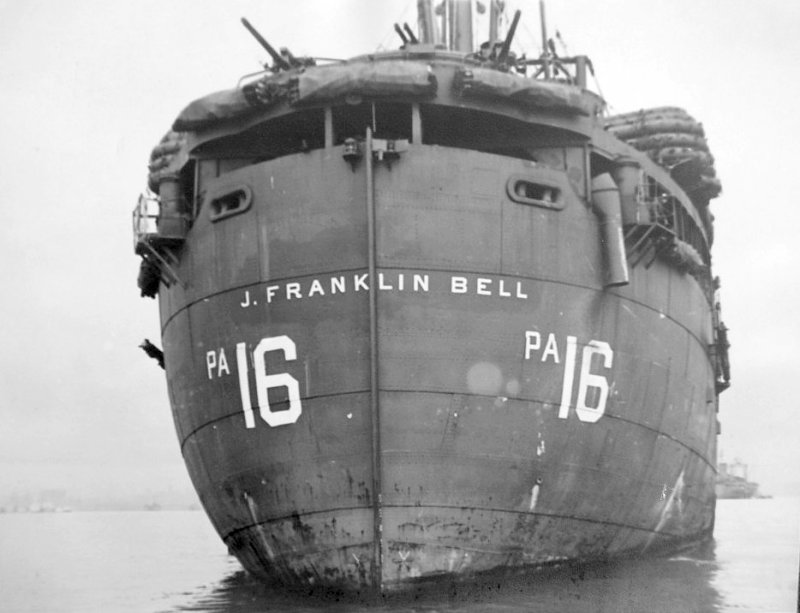
J. Franklin Bell returned to the Western Pacific, putting into Manus,
Admiralties, 3 October to embark 1,600 assault troops for the invasion of
the Philippines. She headed for Leyte Gulf 14 October and arrived off Dulag,
Leyte, 20 October. After quickly debarking her troops, she began unloading
supplies and receiving casualties. Defying repeated air attacks, she unloaded
supplies into LCTs throughout the day and night completing the task shortly
after noon the next day. Then she got under way for Manus, Admiral of the
Fleet, Lord Roger Keyes, RN, on board, and arrived the 27th.
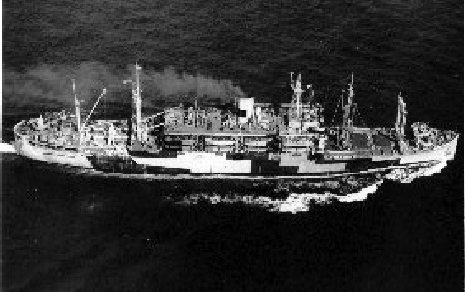
Following a voyage to New Guinea, J. Franklin Bell departed Manus for San
Francisco and arrived 27 November. Heading back to the war zone 28 February
1945, the veteran transport arrived Noumea, New Caledonia, 18 April. After
landing exercises and embarking Seabees and their equipment, she headed for
Okinawa via Eniwetok and Ulithi. She dropped anchor at Hagushi 17 June to
debark her Seabees. Subjected to frequent air alerts, she completed her
unloading under cover of a smoke screen late the following afternoon.
The transport then departed on the 22d, carrying 862 casualties to Saipan before proceeding to
Espiritu Santo and Noumea to embark homebound casualties. Departing Noumea 11
July with over 1,700 passengers, -she steamed for San Francisco and arrived
the 27th.

Again, above, the Chemung
The war ended, J. Franklin Bell sailed 21 September for the Western Pacific,
carrying troops to Eniwetok, Okinawa, and Leyte. After boarding homebound
passengers at Leyte, she sailed 27 October and reached Seattle 12 November.
She began coastal operations on the 22d shuttling between Washington and
California ports. She arrived Suisun Bay, Calif., 20
March 1946; and decommissioned the same day.
Transferred to the WSA for disposal, J. Franklin Bell was sold for scrap 3
April 1948, to Boston Metals Co., Baltimore, Md.
J. Franklin Bell received six battle stars for World War II service.
Awards, Citations and Campaign Ribbons
 --- --- 
 --- --- --- ---
Precedence of awards is from top to bottom, left to right
Top Row - Combat Action Ribbon (retroactive) - American Campaign Medal
Bottom Row - Asiatic-Pacific Campaign Medal (7) - World War II Victory Medal - Philippines Liberation Medal
Heywood Class Transport:
- Laid down in 1918 as an Army Transport at New York Shipbuilding Corp, Camden, N.J.
- Completed 1 March 1921 as SS Keystone State
- Turned over to the Pacific Steamship Co. 28 May 1921
- Renamed SS President McKinley 9 June 1922
- Turned over to the Admiral Orient LIne 21 December 1922
- Laid up at Seattle in 1938
- Purchased by the War Department, 26 October 1940, for conversion to a troopship
- Renamed USAT J. Franklin Bell
- Transferred to the Navy 26 December 1941
- Converted to a Naval Transport
- Commissioned USS J. Franklin Bell (AP-34), 2 April 1942, Captain H. J. Grassie in command
- Reclassified an Attack Transport (APA-16), 1 February 1943
- During WWII J. Franklin Bell was assigned to Asiatic-Pacific Theater and participated in the following campaigns:
Asiatic-Pacific Campaigns
| Campaign and Dates |
Campaign and Dates |
Aleutians operation
Attu occupation,11 to 16 May 1943 |
Tinian capture and occupation
24 to 27 July 1944 |
Gilbert Islands operation
Tarawa Atoll capture and occupation, 20 to 27 November 1943 |
Leyte operation
Leyte landings (Dulag), 20 to 21 October 1944 |
Marshall Islands operation
Occupation of Kwajalein and Majuro Atolls, 31 January to 8 February 1944 |
Okinawa Gunto operation
Assault and occupation of Okinawa Gunto, 17 to 22 June 1945 |
Marianas operation
Capture and occupation of Saipan, 16 to 25 June 1944 |
. |
- Decommissioned, 20 March 1946, and returned to the Maritime Commission
- Final Disposition, sold by the Maritime Commission 3 April 1948 to Boston Metals Co., Baltimore Md. for scrapping
- J. Franklin Bell received seven battle stars for World War II service
Specifications:
Displacement 13,529 t.(lt), 21,900 t.(fl)
Length 535' 2"
Beam 72'
Draft 31' 6"
Speed 17 kts.
Complement
- 46 Officers
- 637 Enlisted
Troop Accommodations
- 103 Officers
- 1,740 Enlisted
Cargo Capacity 200,000 cu. ft., 2,300 t.
Armament
- four single 3"/50 dual purpose gun mounts
- two twin 40mm AA gun mounts
- sixteen single 20mm AA gun mounts.
Propulsion
- four Babcock and Wilcox header-type boilers
- one De Laval steam turbine, geared turbine drive
- single propeller
- designated shaft horsepower 9,500
View the J Franklin Bell (APA-16)
DANFS history entry located at the US Naval Historical Center web site

Postcard stamped Mar18, 1948
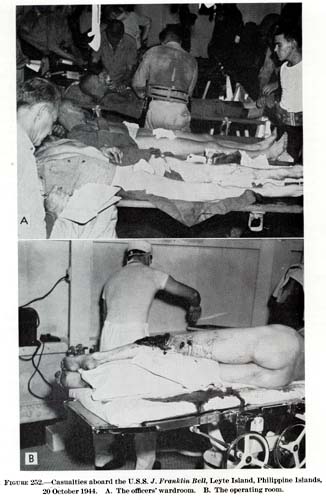
Figure 252: Casualties aboard the U.S.S. J. Franklin Bell, Leyte Island, Phillipines Islands,
20 October 1944. A. The officer's wardroom. B. The Operating Room
Account of Japanese Submarine with mention of the J Franklin Bell:
HIJMS Submarine I-35: Tabular Record of Movement
31 August 1942:
The I-35 is completed at Mitsubishi, Kobe, commissioned in the IJN and based at the Kure Naval District. LtCdr Yamamoto Hideo is assigned as the Commanding Officer. 1 September 1942:
Assigned to the Kure SubRon for working-up with the I-34, RO-100 and the tender SANTOS MARU. September 1942:
Departs Japan for the Aleutians. After arriving, the I-35 conducts patrols with the I-31. 15 November 1942:
Reassigned to Fifth Fleet with the I-34. 28 November 1942:
Departs Kure. Participates in supply missions and patrols in Kiska area while based at Paramushiro, Kuriles. 1 December 1942:
Arrives at Ominato with the I-34. 9-10 December 1942:
Arrives at Kiska. 19 January 1943:
The I-35 departs Kiska for Yokosuka but is recalled after the American landing on Amchitka. 23 January 1943:
En route to Kiska, the light cruiser KISO and the destroyer WAKABA spot an "enemy submarine" and decide to return so as to not compromise their supply mission. Later they learn that the I-35 was patrolling in the same area. 30 January 1943:
The I-35 arrives at her prescribed patrol area off Constantine Harbor, Amchitka. 17 February 1943:
Departs her patrol area, stops briefly at Attu to take aboard a staff officer. 23 February 1943:
Returns to Kure for overhaul. 24 March 1943:
Departs Kure for another supply mission to Kiska. 1 April 1943:
The I-35 is in SubDiv 15 of Rear Admiral Kouta Takero's SubRon 1 with the I-2, -7, -31, -34, -168, -169 and the I-171 in the Northern District Force, Fifth Fleet. SubRon 1 is given the mission to reinforce and resupply the isolated Japanese garrisons in the Aleutian Islands. May 1943:
The I-35 delivers 4 tons of cargo to Kiska. 9 May 1943:
The I-35 departs Paramushiro for a supply run to Attu but is recalled on 12 May and redirected to Holtz Bay area. 11 May 1943: American Operation "Sandcrab" - The Invasion of Attu, Aleutians:
Rear Admiral (later Admiral) Thomas C. Kinkaid's Task Force 16, covered by Rear Admiral Francis W. Rockwell's Task Force 51, lands elements of the Army's 4th and 7th Infantry Divisions under the command of Maj Gen Eugene M. Landrum at Holtz Bay and Massacre Bay that later capture the island. 13 May 1943:
Attu. LtCdr John E. Edwards' USS PHELPS (DD-360) is screening Captain William A. Corn's USS PENNSYLVANIA. The PHELPS makes a sound contact and drops two depth charges. The contact appears stationary during the destroyers' approach, but at the last minute there is a sudden shift in bearing rate and a perceptible change in relative speed, as if the submarine is attempting to escape. At 1530, contact is regained and LtCdr Edwards drops five 600-lb. depth charges and four 300 lb. DCs. Nearby, LtCdr Richard C. Williams, Jr.'s converted fast minelayer USS PRUITT (DM-22/DD-347) reports: "Relative to your pinnacle, one metal drum brought to surface slight diesel oil slick. SMSD and fathometer confirm your hits." A depth charge may have knocked the drum off the submarine's deck. The identity of the submarine is unknown, but the I-35 and the I-34 are operating in the area at the time.
15 May 1943:
Holtz Bay, Attu. In the foggy morning, Cdr John B. McGovern's attack transport USS J. FRANKLIN BELL (APA-16) is completing unloading slowly onto the narrow, rocky beach. The PENNSYLVANIA is standing nearby. A submarine - either the I-35 or the I-34 - launches a salvo of torpedoes launches a salvo of torpedoes at the battleship. At 1140, four torpedoes pass on either side of the BELL and astern of the PENNSYLVANIA. Attempts to destroy the submarine are unsuccessful. The BELL is withdrawn temporarily from the area to avoid further attacks.
16 May 1943:
The I-35 fires two torpedoes at a light cruiser - probably Captain (later Rear Admiral) Russell S. Berkey's SANTA FE (CL-60) - that is part of the invasion covering force. The I-35 is damaged heavily in a depth-charge attack . She surfaces in the fog and escapes, but she cannot resubmerge. LtCdr Yamamoto reports erroneously that he has damaged a light cruiser. 21 May 1943: Operation "KE-Go" - The Evacuation of Kiska:
The Imperial General Headquarters decides to evacuate the garrison at Kiska Island, Aleutians. 2 June 1943:
Returns to Kure, later transferred to Kobe for repairs.
8 September 1943:
The I-35 is reassigned to the Sixth Fleet. Departs Kure, still under LtCdr Yamamoto. 11 October 1943:
Departs Truk to reconnoiter Canton Island and Espiritu Santo. 17 October 1943:
At 0032, LtCdr William D. Irwin's USS NAUTILUS (SS-168), is returning to Pearl after reconnoitering Makin in the Gilbert Islands. He reports sighting a submarine at 19-47N, 181-24. Irwin sees only the conning tower and thinks "it looks like a new type U.S. submarine". Later, ComSubPac advises that it was a Japanese submarine - perhaps the outbound I-35. 19 November 1943:
The I-35 is 300 miles SW of the Hawaiian Islands. She is ordered to proceed to Tarawa in the Gilberts with the I-19, -39, -169 and the I-175. 20 November 1943: American Operation "Galvanic" - The Invasion of the Gilberts:
The Americans invade Tarawa and Makin Islands. The invasion fleet of 200 ships includes 13 battleships and 11 carriers. 22 November 1943:
LtCdr Yamamoto reports sighting an enemy Task Force in the Gilberts area. This is probably Rear Admiral Van H. Ragsdale's TG 53.6 CarDiv 22, comprising the USS SUWANEE (CVE-27), CHENANGO (CVE-28) and the SANGAMON (CVE-26) and its destroyer screen. The I-35 is presumed MIA from this date. 23 November 1943:
W of Betio, Tarawa. The I-35's propeller sounds are detected by Rear Admiral H.F. Kingman's TG 53.4's USS MEADE (DD-602) on an anti-submarine patrol. TG 53.4's FRAZIER (DD-607) joins LtCdr James R. Mulholland's MEADE. Between 1530 and 1738, the destroyers launch five intensive depth charge attacks. The MEADE's final barrage forces the I-35 to battle surface. Both destroyers shell the submarine with 5-inch and 40-mm. fire. At 1751, Cdr Elliott M. Brown's FRAZIER charges in and rams the submarine's port quarter aft of her conning tower, rupturing her pressure hull. The FRAZIER backs off, her bow badly damaged. At 1754, the I-35 sinks stern first at 01-25N, 172-40E. The destroyers launch boats to recover survivors. Three are rescued. A fourth survivor opens fire on his rescuers and is killed. The survivors identify the submarine as the I-35. A total of 92 crewmembers are KIA. 10 January 1944:
Presumed lost with all hands in the Gilberts area. 10 April 1944:
Removed from the Navy List.
|


